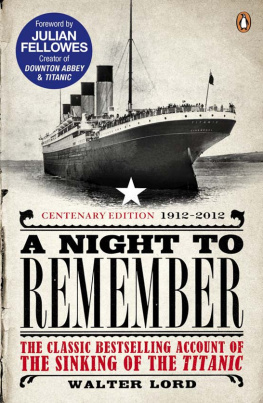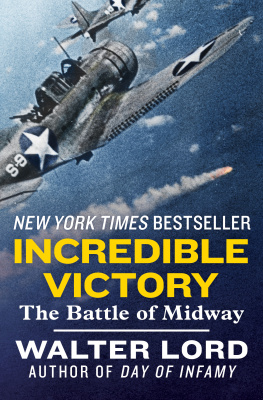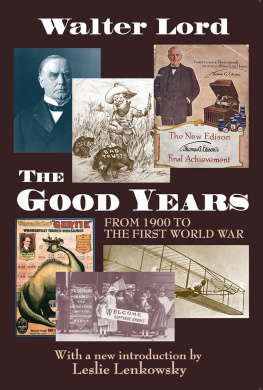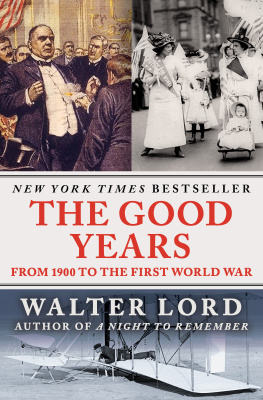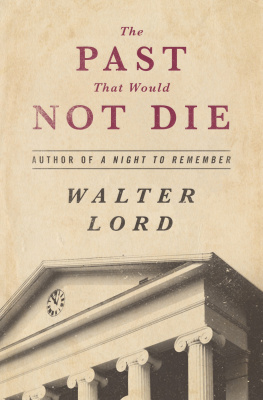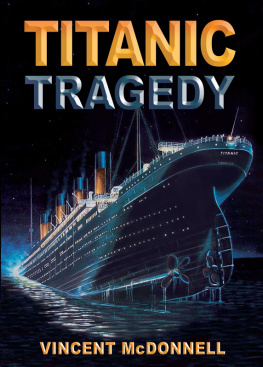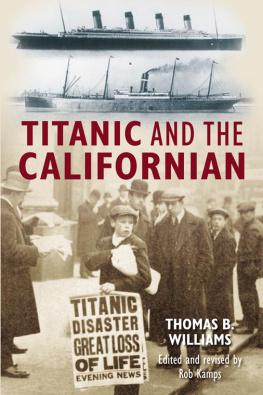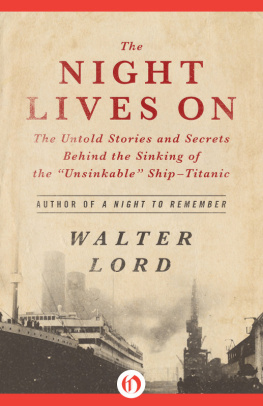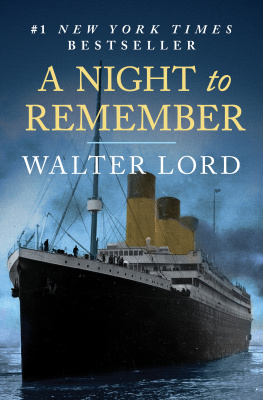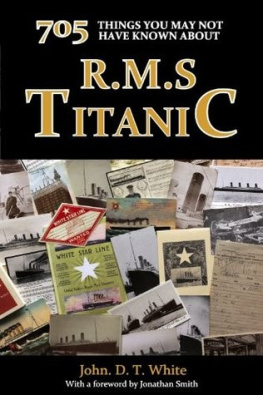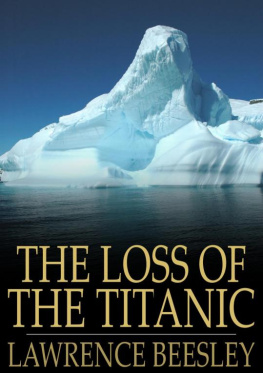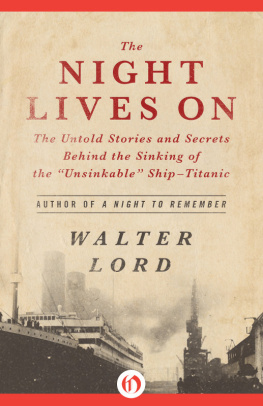ABOUT THE AUTHORS
A graduate of Princeton University and Yale Law, Walter Lord served in England with the American Intelligence Service during the Second World War. His interest in the Titanic dates back to 1926 when, at ten years old, he persuaded his family to cross the Atlantic on the Olympic, sister ship to the doomed ocean liner. Lord was renowned for his knowledge of the Titanic catastrophe, serving as consultant to director James Cameron during the filming of Titanic. A Night to Remember was published in 1956 and has never been out of print. Walter Lord died in 2002.
Julian Fellowes is an actor, writer, director and producer. His film and television work includes Gosford Park, Downton Abbey and Titanic. His novels include Snobs and Past Imperfect.
Brian Lavery is Curator Emeritus at the National Maritime Museum, Greenwich. He is the author of books including Ship: The Epic Story of MaritimeAdventure. He was consultant on the film Master and Commander and the BBCs Empire of the Seas.
Acknowledgements
This book is really about the last night of a small town. The Titanic was that big and carried that many people. To tell everything that happened is impossible; to piece even part of the picture together has required the help of literally hundreds of people.
Many of them were there. Some sixty-three survivors were located, and most of these came through handsomely. They are a stimulating mixture of rich and poor, passengers and crew. But all seem to have two qualities in common. First, they look marvellous. It is almost as though, having come through this supreme ordeal, they easily surmounted everything else and are now growing old with calm, tranquil grace. Second, they are wonderfully thoughtful. It seems almost as if, having witnessed man at his most generous, they scorn any trace of selfishness themselves.
Nothing seems to be too much trouble. Many of the survivors have contributed far beyond the scope of the book, just to help me get a better feeling of what it all was like.
For instance, Mrs Nol MacFie (then the Countess of Rothes) tells how while dining out with friends a year after the disaster she suddenly experienced the awful feeling of cold and intense horror she always associated with the Titanic. For an instant she couldnt imagine why. Then she realized the orchestra was playing The Tales of Hoffmann, the last piece of after-dinner music played that fateful Sunday night.
Mrs George Darby, then Elizabeth Nye, similarly contributes an appealing extra touch when she tells how as it grew bitterly cold early Sunday evening she and some other second-class passengers gathered in the dining room for a hymn-sing, ending with For Those in Peril on the Sea.
And Mrs Katherine Manning then Kathy Gilnagh vividly conveys the carefree spirit of the young people in third class when she talks about the gay party in steerage that same last night. At one point a rat scurried across the room; the boys gave chase; and the girls squealed with excitement. Then the party was on again. Mrs Mannings lovely eyes still glow as she recalls the bagpipes, the laughter, the fun of being a pretty colleen setting out for America.
Most of the survivors, in fact, give glimpses of shipboard life that have an almost haunting quality. You feel it when Mrs G. J. Mercherle (then Mrs Albert Caldwell) recalls the bustle of departing from Southampton when Victorine Perkins (then Chandowson) tells of the Ryersons sixteen trunks when Mr Spencer Silverthorne remembers his pleasant dinner with the other buyers on Sunday night when Marguerite Schwarzenbach (then Frolicher) describes a quieter supper in her parents stateroom she had been sea-sick and this was her first gingerly attempt to eat again.
The crews recollections have this haunting quality too. You feel it when fireman George Kemish describes the gruff camaraderie of the boiler rooms and when masseuse Maud Slocombe tells of her desperate efforts to get the Turkish bath in apple-pie order. Apparently there was a half-eaten sandwich or empty beer bottle in every nook and corner. The builders were Belfast men, she explains cheerfully.
The atmosphere conveyed by these people somehow contributes as much as the facts and incidents they describe. I appreciate their help enormously.
Other survivors deserve all my thanks for the way they painstakingly reconstructed their thoughts and feelings as the ship was going down. Jack Ryerson searched his mind to recall how he felt as he stood to one side, while his father argued to get him into boat 4. Did he realize his life was hanging in the balance? No, he didnt think very much about it. He was an authentic thirteen-year-old boy.
Washington Dodge Jrs chief impression was the earsplitting roar of steam escaping from the Titanics huge funnels. He was an authentic five-year-old.
Third-class passengers Anna Kincaid (then Sjoblom), Celiney Decker (then Yasbeck) and Gus Cohen have also contributed far more than interesting narratives. They have been especially helpful in recreating the atmosphere that prevailed in steerage a long-neglected side of the story.
The crew too have provided much more than accounts of their experiences. The deep feeling in baker Charles Burgesss voice, whenever he discusses the Titanic, reveals the intense pride of the men who sailed her. The gracious courtesy of stewards James Witter, F. Dent Ray, Alfred Pugh and Leo James Hyland points up the matchless service enjoyed by the passengers. And the thoroughness of men like Quartermaster George Thomas Rowe, baker Walter Belford and greaser Walter Hurst confirms fireman Kemishs boast that the crew were the pick of Southampton.
To these and many other Titanic survivors like Mrs Jacques Futrelle, Mrs Henry B. Harris, Mrs H. A. Cassebeer, Mrs M. V. Mann, Mrs A. C. Williams, Harry Giles, Charles Joughin and Herbert J. Pitman go my heartfelt thanks for their time and trouble.
The relatives of people on the Titanic have been equally cooperative. One letter recently made available by the descendant of a survivor illustrates how far theyve gone. It is a letter written to the survivor himself, shortly after the accident. I have left out all names, but the act of making this data available shows a courage and honesty that effectively rebut the charge made in the letter:
Dear : I have before me information stating that you attempted to force your way into one of the lifeboats and that when ordered back by Major Butt, you slipped from the crowd, disappeared, and after a few moments were seen coming from your stateroom dressed in womens clothing which was recognized as garments worn by your wife en route.
I cant understand how you can hold your head up and call yourself a man among men, knowing that every breath you draw is a lie. If your conscience continues to bother you after reading this, you had better come forward. There is no truer saying than the old one, Confession is good for the soul.
Yours truly,
Besides making letters available, many of the relatives have supplied fascinating information themselves. Especially, I want to thank Captain Smiths daughter, Mrs M. R. Cooke, for the charming recollection of her gallant father Mrs Sylvia Lightoller for her kindness in writing to me about her late husband, Commander Charles Lightoller, who distinguished himself in 1940 by taking his own boat over to Dunkirk Mrs Alfred Hess for making available the family papers of Mr and Mrs Isidor Straus Mrs Cynthia Fletcher for a copy of the letter written by her father, Hugh Woolner, on board the Carpathia Mr Fred G. Crosby and his son John for help in obtaining information on Captain Edward Gifford Crosby and Mrs Victor I. Minahan, for the interesting details about Dr and Mrs William Minahan and their daughter Daisy.

